PP水英文版MSDS
聚丙烯PPMSDS
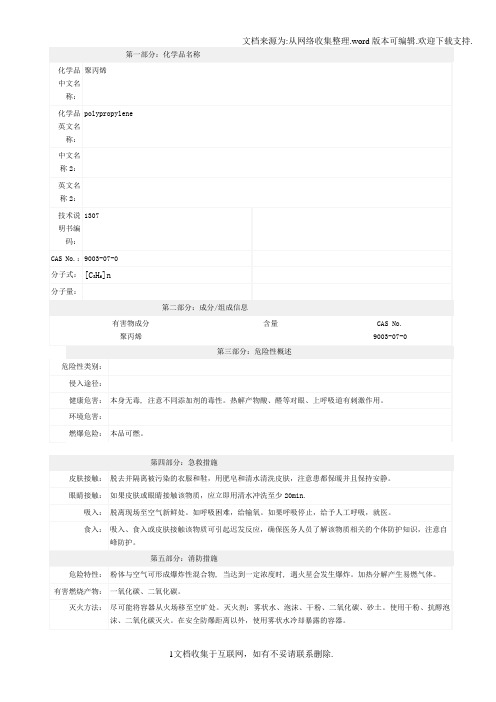
主要用途: 可用作工程塑料, 适用于制电视机、收音机外壳、电器绝缘材料、防腐管道、板材、贮槽等, 也用于编 织包装袋、包装薄膜。
其它理化性质:
第十部分:稳定性和反应活性
稳定性:
禁配物: 与强酸、氯及其他强氧化剂,高锰酸钾、异丙基油类不能配伍
避免接触的条 件:
聚合危害:
分解产物:
第十一部分:毒理学资料
第七部分:操作处置与储存 操作注意事项: 密闭操作。密闭操作,提供良好的自然通风条件。操作人员必须经过专门培训,严格遵守操作规程。建
议操作人员佩戴自吸过滤式防尘口罩。远离火种、热源,工作场所严禁吸烟。使用防爆型的通风系统和 设备。避免与氧化剂接触。搬运时要轻装轻卸,防止包装及容器损坏。配备相应品种和数量的消防器材 及泄漏应急处理设备。倒空的容器可能残留有害物。 储存注意事项: 储存于阴凉、通风的库房。远离火种、热源。应与氧化剂分开存放,切忌混储。配备相应品种和数量的 消防器材。储区应备有合适的材料收容泄漏物。
第十六部分:其他信息
参考据审核单位:
修改说明:
其他信息:
MSDS 修改日期:
4文档收集于互联网,如有不妥请联系删除.
饱和蒸气压 无资料 (kPa):
燃烧热 无资料 (kJ/mol):
临界温度(℃): 无资料
临界压力(MPa): 无资料
辛醇/水分配系 无资料 数的对数值:
闪点(℃): 无资料
引燃温度(℃): 420(粉云)
爆炸上 无资料 限%(V/V):
爆炸下 20(g/m3) 限%(V/V):
溶解性: 在水中漂浮
有害物成分 聚丙烯
危险性类别:
含量 第三部分:危险性概述
CAS No. 9003-07-0
pp水

含量 ≥45.3%CAS No. 7722-来自4-7第三部分:危险性概述
危险性类别:
侵入途径:
健康危害: 吸入后可引起呼吸道损害。溅落眼睛内,刺激结膜,重者致灼伤。刺激皮肤。浓溶液或结晶 对皮肤有腐蚀性。口服腐蚀口腔和消化道,出现口内烧灼感、上腹痛、恶心、呕吐、口咽肿 胀等。口服剂量大者,口腔粘膜呈棕黑色、肿胀糜烂,剧烈腹痛,呕吐,血便,休克,最后
TLVTN: ACGIH 5mg[Mn]/m3
TLVWN: 未制定标准
监测方法: 磷酸-高碘酸钾比色法;冷原子吸收光谱法
工程控制: 生产过程密闭,加强通风。提供安全淋浴和洗眼设备。
呼吸系统防护: 可能接触其粉尘时,建议佩戴头罩型电动送风过滤式防尘呼吸器。
眼睛防护: 呼吸系统防护中已作防护。
身体防护: 穿胶布防毒衣。
死于循环衰竭。 环境危害: 燃爆危险: 本品助燃,具腐蚀性、刺激性,可致人体灼伤。
第四部分:急救措施 皮肤接触: 立即脱去污染的衣着,用大量流动清水冲洗至少 15 分钟。就医。 眼睛接触: 立即提起眼睑,用大量流动清水或生理盐水彻底冲洗至少 15 分钟。就医。
吸入: 迅速脱离现场至空气新鲜处。保持呼吸道通畅。如呼吸困难,给输氧。如呼吸停止,立即进 行人工呼吸。就医。
溶解性: 溶于水、碱液,微溶于甲醇、丙酮、硫酸。
主要用途: 用于有机合成、油脂工业、氧化、医药、消毒等。
其它理化性质: 240
第十部分:稳定性和反应活性
稳定性:
禁配物: 强还原剂、活性金属粉末、硫、铝、锌、铜及其合金、易燃或可燃物。 避免接触的条件:
聚合危害: 分解产物:
第十一部分:毒理学资料 急性毒性: LD50:1090 mg/kg(大鼠经口)
聚丙烯 PP MSDS
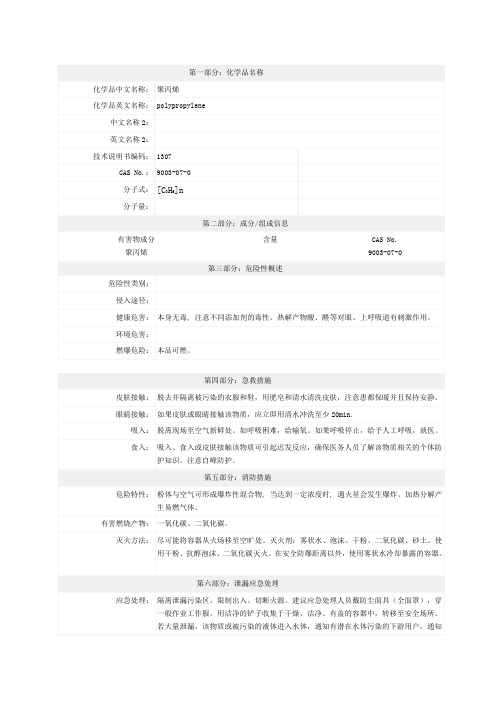
化学品中文名称:
聚丙烯
化学品英文名称:
polypropylene
中文名称2:
英文名称2:
技术说明书编码:
1307
CAS No.:
9003-07-0
分子式:
[C3H6]n
分子量:
第二部分:成分/组成信息
有害物成分
含量
CAS No.
聚丙烯
9003-07-0
第三部分:危险性概述
危险性类别:
储存注意事项:
储存于阴凉、通风的库房。远离火种、热源。应与氧化剂分开存放,切忌混储。配备相应品种和数量的消防器材。储区应备有合适的材料收容泄漏物。
第八部分:接触控制/个体防护
职业接触限值
中国MAC(mg/m3):
10
前苏联MAC(mg/m3):
10
TLVTN:
未制定标准
TLVWN:
未制定标准
监测方法:
有害燃烧产物:
一氧化碳、二氧化碳。
灭火方法:
尽可能将容器从火场移至空旷处。灭火剂:雾状水、泡沫、干粉、二氧化碳、砂土。使用干粉、抗醇泡沫、二氧化碳灭火。在安全防爆距离以外,使用雾状水冷却暴露的容器。
第六部分:泄漏应急处理
应急处理:
隔离泄漏污染区,限制出入。切断火源。建议应急处理人员戴防尘面具(全面罩),穿一般作业工作服。用洁净的铲子收集于干燥、洁净、有盖的容器中,转移至安全场所。若大量泄漏,该物质或被污染的液体进入水体,通知有潜在水体污染的下游用户,通知地方卫生、消防官员和污染控制部门。收集回收或运至废物处理场所处置。
无资料
燃烧热(kJ/mol):
无资料
临界温度(℃):
无资料
临界压力(MPa):
TOTAL PP MSDS
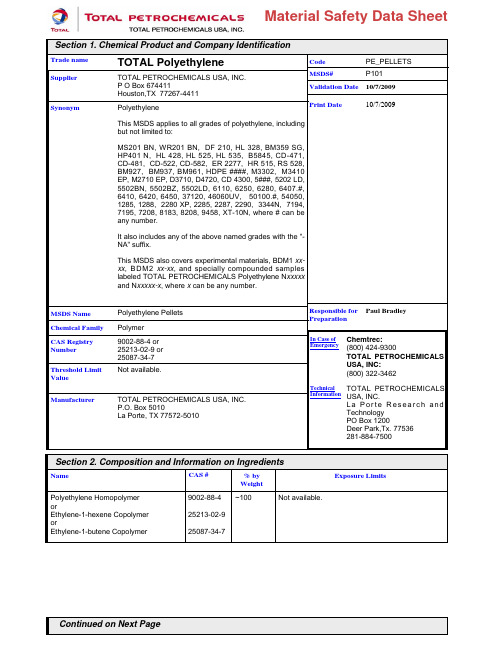
Trade name PolyethyleneThis MSDS applies to all grades of polyethylene, including but not limited to:MS201 BN, WR201 BN, DF 210, HL 328, BM359 SG,HP401 N, HL 428, HL 525, HL 535, B5845, CD-471,CD-481, CD-522, CD-582, ER 2277, HR 515, RS 528,BM927, BM937, BM961, HDPE ####, M3302, M3410EP, M2710 EP, D3710, D4720, CD 4300, 5###, 5202 LD,5502BN, 5502BZ, 5502LD, 6110, 6250, 6280, 6407.#,6410, 6420, 6450, 37120, 46060UV, 50100.#, 54050,1285, 1288, 2280 XP, 2285, 2287, 2290, 3344N, 7194,7195, 7208, 8183, 8208, 9458, XT-10N, where # can be any number.It also includes any of the above named grades with the "-NA" suffix.This MSDS also covers experimental materials, BDM1 xx-xx , BDM2 xx-xx , and specially compounded samples labeled TOTAL PETROCHEMICALS Polyethylene N xxxxx and N xxxxx-x , where x can be any number.P101PE_PELLETS Not available.Chemtrec:(800) 424-9300TOTAL PETROCHEMICALS USA, INC:(800) 322-3462TOTAL PETROCHEMICALS USA, INC.P.O. Box 5010La Porte, TX 77572-501010/7/200910/7/2009Material Safety Data SheetSupplierSynonymThreshold Limit Value ManufacturerCode MSDS#Validation Date Print DateIn Case of EmergencySection 1. Chemical Product and Company IdentificationResponsible for PreparationPaul BradleyTechnical InformationTOTAL PETROCHEMICALS USA, INC.L a P o r t e R e s e a r c h a n d Technology PO Box 1200Deer Park,Tx. 77536281-884-7500TOTAL PolyethyleneMSDS Name Polyethylene Pellets Chemical Family Polymer 9002-88-4 or 25213-02-9 or 25087-34-7CAS Registry Number TOTAL PETROCHEMICALS USA, INC.P O Box 674411Houston,TX 77267-4411Section 2. Composition and Information on IngredientsNameCAS #% by Weight Exposure LimitsPolyethylene Homopolymer 9002-88-4~100Not available.orEthylene-1-hexene Copolymer 25213-02-9orEthylene-1-butene Copolymer25087-34-7CARCINOGENIC EFFECTS : Polyethylene is not a known carcinogen. Not listed as a carcinogen by OSHA, NTP or IARC.FOR HOT MATERIAL: Skin contact. Eye contact. Inhalation.Emergency Overview Medical Conditions Aggravated by OverexposureThere is no known effect from chronic exposure to this product. Repeated or prolonged exposure is not known to aggravate medical condition.No adverse health effects anticipated from the solid pellet.Overexposure/Signs/SymptomsSection 3. Hazards IdentificationRoutes of EntryPotential Acute Health EffectsPotential Chronic Health EffectsNegligible at room temperature. Nuisance dusts can be irritating to the upper respiratory tract.Irritating vapors may form when the polymer is processed at high temperatures.Dust may cause mechanical irritation to eye.Heated Polymer: Eye contact can cause serious thermal burns. Vapors formed when polymer is heated may be irritating to the eye.No effects are expected for ingestion of small amounts. May be a choking hazard.No known acute effects of this product resulting from skin contact at room temperature.Heated Polymer: skin contact can cause serious thermal burns.Eyes Skin Inhalation Ingestion Physical State and AppearanceSolid. (Solid)See Toxicological Information (Section 11)Irritating vapors to respiratory system and eyes may form when polymer is processed at high temperatures. Molten or heated material in skin contact can cause severe burns.No First Aid procedures are needed.Rinse with water for a few minutes. Seek medical attention if necessary.Polymer: NO known EFFECT on skin contact, rinse with water for few minutes.Heated Polymer: For serious burns from heated polymer, get medical attention. In case of skin contact, immediately immerse in or flush with clean, cold water.Allow the victim to rest in a well ventilated area.Section 4. First Aid MeasuresEye Contact Skin ContactInhalation Ingestion349°C (660.2°F)May be combustible at high temperature.Carbon oxides (CO, CO2) and soot.CLOSED CUP: 341°C (645.8°F).Not available.No specific information is available in our database regarding the flammability of this product in presence of various materials.Risks of explosion of the product in presence of mechanical impact: Not expected.Risks of explosion of the product in presence of static discharge: Possible.Risk of explosion from dust accumulation of this product is possible. See MSDS section 7Handling for more information.Section 5. Fire Fighting MeasuresFlammability of the Product Auto-ignition Temperature Flash Points Flammable Limits Products of Combustion Fire Hazards in Presence of Various Substances Explosion Hazards in Presence of Various SubstancesFire may produce irritating gases and dense smoke.Flowing material may produce static discharge, igniting dust accumulations.Processing or material handling equipment may generate dust of sufficiently small particle size, that when suspended in air may be explosive.Fire Fighting Media and InstructionsSpecial Remarks on Fire HazardsSpecial Remarks on Explosion HazardsWear MSHA/NIOSH approved self-contained breathing apparatus or equivalent and full protective gear.Protective Clothing (Fire)SMALL FIRE: Dry chemical extinguisher (ABC or AB). Use water spray or RGE FIRE: Use water spray or fog. Do not use water jet.May re-ignite itself after fire is extinguished.Pellets on the floor could present a serious slipping problem.Good housekeeping must be maintained at all times to avoid this hazard.Sweep, shovel, or vacuum material into clean containers.Use a shovel to put the material into a convenient waste disposal container. Do not allow any potentially contaminated water with pellets to enter any waterway, sewer or drain.Section 6. Accidental Release MeasuresSmall Spill and LeakLarge Spill and LeakKeep container dry. Keep in a cool place. Ground all equipment containing material. Keep container tightly closed. Keep in a cool, well-ventilated place. Combustible materials should be stored away from extreme heat and away from strong oxidizing agents.Section 7. Handling and StorageHandlingStorageHandling of plastic may form nuisance dust. Protect personnel.Pneumatic material handling and processing equipment may generate dust of sufficiently small particle size that, when suspended in air, may be explosive. Dust accumulations should be controlled through a comprehensive dust control program that includes, but is not limited to,source capture, inspection and repair of leaking equipment, routine housekeeping and employee training in hazards. See NFPA 654.When handled in bulk quantities, this product and its associated packaging may present a crushing hazard due to the large masses involved, possibly resulting in severe injury or death.Consult local authorities for acceptable exposure limits.Polyethylene Not available.orEthylene-1-hexene Copolymer orEthylene-1-butene CopolymerSolid. (Solid)Negligible.126 to 136°C (258.8 to 276.8°F)0.91 to 0.97 (Water = 1)Insoluble in water.Not applicable.Odorless.Not available.Translucent white pellets.Melting/Freezing Point Section 9. Physical and Chemical PropertiesPhysical State and Appearance Molecular Weight Specific Gravity VolatilitySolubility in WaterOdor Taste Color(-CH2-CH2-)xMolecular Formula The product is stable. Avoid temperatures above 300 degree C (570 F).May react or be incompatible with oxidizing materials.No.Hazardous decomposition products are carbon monoxide, carbon dioxide, dense smoke, andvarious hydrocarbons.Section 10. Stability and ReactivityStability and Reactivity Incompatibility with Various SubstancesHazardous Decomposition Products HazardousPolymerizationLD50: Not available.LC50: Not available.Not considered to be dangerous to humans.CARCINOGENIC EFFECTS: Not listed as a carcinogen by OSHA, NTP or IARC.Section 11. Toxicological InformationToxicity to Animals Chronic Effects on HumansOther Toxic Effects on HumansNot available.Not available.No additional information.Section 12. Ecological InformationEcotoxicity BOD5 and COD Biodegradable/OECD Toxicity of the Products of BiodegradationNot available.Not available.MobilityTransfer to an approved disposal area in accordance with federal, state, and local regulations.Waste InformationSection 13. Disposal ConsiderationsConsult your local or regional authorities.U.S. Federal RegulationsHCS Classification TSCA inventory: All the ingredients are on the TSCA list.SARA 301/302/303No chemicals in this product are listed as extremely hazardous substances in 40 CFR 355,Emergency Planning And Notification (Appendix A to Part 355).--------------------------------------SARA 304No chemicals in this product require reporting under the requirement of 40 CFR 355,Emergency Planning And Notification (SARA extremely hazardous substances listed inAppendix A to Part 355 or CERCLA hazardous substances listed in Table 302.4 of 40 CFR Part 302).--------------------------------------SARA 313This product contains no chemicals in excess of the applicable de minimis concentration that are subject to the reporting requirements of Section 313 of Title III of the Superfund Amendments and Reauthorization Act of 1986 and 40 CFR Part 372 (Table 372.65).--------------------------------------SARA 311/312This product is not a “Hazardous Chemical” as defined by the OSHA Hazard Communication Standard, 29 CFR 1910.1200, and as such does not require reporting under the requirements of 40 CFR 370, Hazardous Chemical Reporting: Community Right-To-Know.--------------------------------------Specific state and local regulations should be consulted to determine if there are any additionalSection 15. Regulatory InformationThis product is not a "Hazardous Chemical" as defined by the OSHA Hazard Communication Standard, 29 CFR 1910.1200.Connecticut Carcinogen Reporting: This material is not listed.Connecticut Hazardous Material Survey: This material is not listed.Florida substances: This material is not listed.Illinois Chemical Safety Act: This material is not listed.Illinois Toxic Substances Disclosure to Employee Act: This material is not listed.Louisiana Reporting: This material is not listed.Louisiana Spill: This material is not listed.Massachusetts Spill: This material is not listed.Massachusetts Substances: This material is not listed.Michigan Critical Material: This material is not listed.Minnesota Hazardous Substances: This material is not listed.New Jersey Hazardous Substances: This material is not listed.New Jersey Spill: This material is not listed.New Jersey Toxic Catastrophe Prevention Act: This material is not listed.New York Acutely Hazardous Substances: This material is not listed.New York Toxic Chemical Release Reporting: This material is not listed.Pennsylvania RTK Hazardous Substances: This material is not listed.Rhode Island Hazardous Substances: This material is not listed.California Prop. 65: There are no Proposition 65 chemicals present in our polyethylene resins at levels that would require a warning under the California Safe Drinking Water and Toxic Enforcement Act.Clean water act (CWA) 307: No products were found.Clean water act (CWA) 311: No products were found.Clean air act (CAA) 112 accidental release prevention: No products were found.Clean air act (CAA) 112 regulated flammable substances: No products were found.Clean air act (CAA) 112 regulated toxic substances: No products were found.State RegulationsCEPA Toxic substances: This material is not listed.Canadian ARET: This material is not listed.Canadian NPRI: This material is not listed.Alberta Designated Substances: This material is not listed.Ontario Designated Substances: This material is not listed.Quebec Designated Substances: This material is not listed.Australia inventory (AICS): This material is listed or exempted.Canada inventory: All the ingredients are on the DSL or NDSL.China inventory (IECSC): This material is listed or exempted.Japan inventory (ENCS): This material is listed or exempted.Japan inventory (ISHL): Not determined.Korea inventory (KECI): This material is listed or exempted.New Zealand Inventory of Chemicals (NZIoC): This material is listed or exempted.Philippines inventory (PICCS): This material is listed or exempted.WHMIS (Canada)Not controlled under WHMIS (Canada).This product is not classified according to EU legislation.DSCL (EEC)International RegulationsInternational Lists requirements. Because many states and localities have added requirements or incorporated the Federal contents in their own forms, Tier I & II forms should be obtained from the State Emergency Response Commission (SERC).Chemtox DatabaseHazardous Substance DatabaseSection 16. Other InformationReferencesHazardous Material Information System (U.S.A.)0101National Fire Protection Association (U.S.A.)HealthSpecific HazardReactivity Fire HazardReactivityPersonal ProtectionIrritating vapors to respiratory system and eyes may form when polymer is processed at high temperatures. Molten or heated material in skin contact can cause severe burns.Label requirementsChemtrec:(800) 424-9300TOTAL PETROCHEMICALS USA, INC:(800) 322-3462Acceptable business/technical terms necessary for medical device applications must be developed by contacting your TOTAL PETROCHEMICALS USA, INC. sales representative. Without suchdocumented business terms, TOTAL PETROCHEMICALS USA, INC. makes no representations and disclaims all warranties, express or implied, concerning biocompatibility and/or suitability of this product for medical device applications.Other Special ConsiderationsValidated by Paul Bradley on 10/7/2009.Verified by Karen Scheel.Printed 10/7/2009.Notice to ReaderTo the best of our knowledge, the information contained herein is accurate. However, neither the above named supplier nor any of its subsidiaries assumes any liability whatsoever for the accuracy or completeness of the information contained herein. Final determination of suitability of any material is the sole responsibility of the user. All materials may present unknown hazards and should be used with caution. Although certain hazards are described herein, we cannot guarantee that these are the only hazards that exist.19.02To obtain an electronic copy of this MSDS, please email: product.stewardship@.。
MSDS-PP聚氨酯
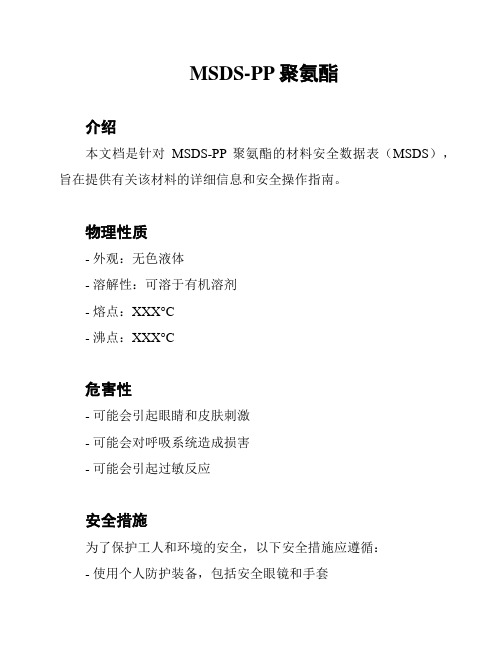
MSDS-PP聚氨酯
介绍
本文档是针对MSDS-PP聚氨酯的材料安全数据表(MSDS),旨在提供有关该材料的详细信息和安全操作指南。
物理性质
- 外观:无色液体
- 溶解性:可溶于有机溶剂
- 熔点:XXX°C
- 沸点:XXX°C
危害性
- 可能会引起眼睛和皮肤刺激
- 可能会对呼吸系统造成损害
- 可能会引起过敏反应
安全措施
为了保护工人和环境的安全,以下安全措施应遵循:
- 使用个人防护装备,包括安全眼镜和手套
- 在操作过程中保持良好的通风
- 遵循正确的操作程序,避免产生粉尘或气体
- 避免接触皮肤和眼睛
- 在使用后妥善处理废弃物
急救措施
如果发生不慎接触或意外暴露,应立即采取以下急救措施:
- 如果接触了眼睛,立即用大量清水冲洗至少15分钟,并寻求医疗帮助
- 如果接触了皮肤,立即用肥皂和水冲洗,并寻求医疗帮助
- 如果吸入进入呼吸道,请将患者移到新鲜空气中,并寻求医疗帮助
- 如果意外吞食,请给予大量清水漱口,并寻求医疗帮助
应急处理
在泄漏事故或其他应急情况发生时,应该采取以下措施:
- 尽量避免直接接触泄露物
- 使用适当的个人防护装备进行处理
- 阻止泄漏扩散到水源或下水道
- 使用吸收剂进行泄露物的清除和处理
- 根据当地法规和规定进行废弃物处置
以上信息仅为提供基本的安全指导,具体的操作和应对措施取决于特定情况,请在使用该材料之前仔细阅读并遵循其标签和手册上的相关信息。
> 注意:本材料的相关信息不能100%确认,因此请在使用之前自行确认。
聚丙烯 PP MSDS

戴一般作业防护手套。
其他防护:
工作现场严禁吸烟。保持良好的卫生习惯。
第九部分:理化特性
主要成分:
纯品
外观与性状:
白色、无臭、无味,能缓慢燃烧的可燃性品状固体。
pH:
熔点(℃):
165-170
沸点(℃):
无资料
相对密度(水=1):
0.90-0.91
相对蒸气密度(空气=1):
无资料
饱和蒸气压(kPa):
法规信息化学危险物品安全管理条例1987月17日国务院发布化学危险物品安全管理条例实施细则化劳发1992677号工作场所安全使用化学品规定1996劳部发423号等法规针对化学危险品的安全使用生产储存运输装卸等方面均作了相应规定
第一部分:化学品名称
化学品中文名称:
聚丙烯
化学品英文名称:
polypropylene
其它理化性质:
第十部分:稳定性和反应活性
稳定性:
禁配物:
与强酸、氯及其他强氧化剂,高锰酸钾、异丙基油类不能配伍
避免接触的条件:
聚合危害:
பைடு நூலகம்分解产物:
第十一部分:毒理学资料
急性毒性:
LD50:无资料
LC50:无资料
亚急性和慢性毒性:
刺激性:
致敏性:
致突变性:
致畸性:
致癌性:
第十二部分:生态学资料
生态毒理毒性:
生物降解性:
非生物降解性:
生物富集或生物积累性:
其它有害作用:
无资料。
第十三部分:废弃处置
废弃物性质:
废弃处置方法:
处置前应参阅国家和地方有关法规。建议用焚烧法处置。
废弃注意事项:
第十四部分:运输信息
PP水MSDS

PP水化学品安全技术说明书第一部分:化学品名称化学品中文名称:PP水化学品英文名称:potassium permanganate 中文名称2:高锰酸钾溶液英文名称2:技术说明书编码:534 CAS No.:7722-64-7 分子式:KMnO4 分子量:158.03第二部分:成分/组成信息有害物成分含量CAS No. 高锰酸钾≥99.3%7722-64-7第三部分:危险性概述危险性类别:侵入途径:健康危害:吸入后可引起呼吸道损害。
溅落眼睛内,刺激结膜,重者致灼伤。
刺激皮肤。
浓溶液或结晶对皮肤有腐蚀性。
口服腐蚀口腔和消化道,出现口内烧灼感、上腹痛、恶心、呕吐、口咽肿胀等。
口服剂量大者,口腔粘膜呈棕黑色、肿胀糜烂,剧烈腹痛,呕吐,血便,休克,最后死于循环衰竭。
环境危害:燃爆危险:本品助燃,具腐蚀性、刺激性,可致人体灼伤。
第四部分:急救措施皮肤接触:立即脱去污染的衣着,用大量流动清水冲洗至少15分钟。
就医。
眼睛接触:立即提起眼睑,用大量流动清水或生理盐水彻底冲洗至少15分钟。
就医。
吸入:迅速脱离现场至空气新鲜处。
保持呼吸道通畅。
如呼吸困难,给输氧。
如呼吸停止,立即进行人工呼吸。
就医。
食入:用水漱口,给饮牛奶或蛋清。
就医。
第五部分:消防措施危险特性:强氧化剂。
遇硫酸、铵盐或过氧化氢能发生爆炸。
遇甘油、乙醇能引起自燃。
与有机物、还原剂、易燃物如硫、磷等接触或混合时有引起燃烧爆炸的危险。
有害燃烧产物:氧化钾、氧化锰。
灭火方法:采用水、雾状水、砂土灭火。
第六部分:泄漏应急处理应急处理:隔离泄漏污染区,限制出入。
建议应急处理人员戴防尘面具(全面罩),穿防毒服。
不要直接接触泄漏物。
小量泄漏:用砂土、干燥石灰或苏打灰混合。
用洁净的铲子收集于干燥、洁净、有盖的容器中。
大量泄漏:收集回收或运至废物处理场所处置。
第七部分:操作处置与储存操作注意事项:密闭操作,加强通风。
操作人员必须经过专门培训,严格遵守操作规程。
建议操作人员佩戴头罩型电动送风过滤式防尘呼吸器,穿胶布防毒衣,戴氯丁橡胶手套。
聚丙烯酰胺MSDS英文
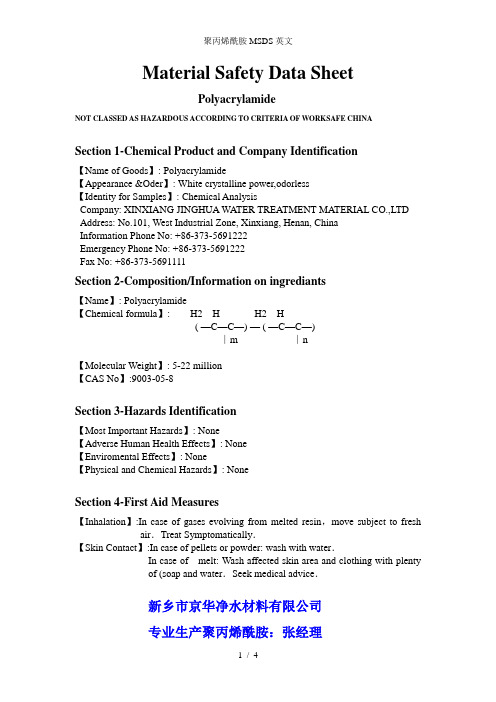
Material Safety Data SheetPolyacrylamideNOT CLASSED AS HAZARDOUS ACCORDING TO CRITERIA OF WORKSAFE CHINASection 1-Chemical Product and Company Identification【Name of Goods】: Polyacrylamide【Appearance &Oder】: White crystalline power,odorless【Identity for Samples】: Chemical AnalysisCompany: XINXIANG JINGHUA WATER TREATMENT MATERIAL CO.,LTD Address: No.101, West Industrial Zone, Xinxiang, Henan, ChinaInformation Phone No: +86-373-5691222Emergency Phone No: +86-373-5691222Fax No: +86-373-5691111Section 2-Composition/Information on ingrediants【Name】: Polyacrylamide【Chemical formula】: H2 H H2 H( —C—C—) — ( —C—C—)∣m ∣n【Molecular Weight】: 5-22 million【CAS No】:9003-05-8Section 3-Hazards Identification【Most Important Hazards】: None【Adverse Human Health Effects】: None【Enviromental Effects】: None【Physical and Chemical Hazards】: NoneSection 4-First Aid Measures【Inhalation】:In case of gases evolving from melted resin,move subject to fresh air.Treat Symptomatically.【Skin Contact】:In case of pellets or powder: wash with water.In case of melt: Wash affected skin area and clothing with plentyof (soap and water.Seek medical advice.新乡市京华净水材料有限公司专业生产聚丙烯酰胺:张经理【Eye Contact】:In case of pellets or powder,flush with plenty of water for at least 15 minutes.Seek medical advice if any dust particles still remain.Incase of gases evolving from melted resin of high temperature. Flushwith plenty of water for at least l5 minutes. Seek medical advice ifnecessary.【Ingestion】:Induce vomiting.Rinse mouth with water.Seek medical advice if Necessary.Section 5-Fire Fighting Measures【Extinguishing Media】: Water,Foam,Dry chemical powder【Special Fire-Fighting Procedure】: Self contained breathing apparatus【Fire and Explosion Hazards】: NoneSection 6-Accident Release MeasuresIf spilled on road or floor, sweep and collect materials to prevent slipping all fal1ing,Released materials must be collected for environmental protection.Section 7-Handling and Storage【Handling】: Prevent from fire around handling area.Maintain good house keeping standards to prevent accumulation of dust.To avoid dust explosion,resulting from the existence of powder,electrostatics eliminatorsand grounding should be fixed to such equipment as air transferringpipes,bag filters and hoppers. Use electrically conductive filters forbag filters.【Storage】: Keep the materials at a cool dry place. Protect from direct sunlight, rain and violent temperature fluctuation. Fire is inhibited around storagearea.Section 8-Physical and Chemical Properties【Threshold Limit Value】: Not determined【Ventilation】: Necessary to exclude dust, fumes and gases.【Personal Protection Eye】:Wear safety glasses for general purpose.WearChemical goggles for cleaning moldingmachines.【Respiratory】: Wear masks for cleaning molding machines.【Gloves】: Necessary for handling melted resin.Section 9-Physical and Chemical Properties【Appearance】: White crystalloid【Boiling Point Temperature】: Above 104℃【Solubility】: Insoluble in water【Specific Gravity】: 1.13Section10-Stability and Reactivity【Flammability】: No information【Flash Point】: No determined【Auto-ignition Temperature】: No【Reactivity with Water】: No【Stability】: Stable and non—reactive under normalhandling and storage condition.【Thermal Decomposition Gases】: CO,SM and MMA ZOWO TECHNOLOGYSection 11-Toxico Logical Information【Irritation】: Fumes or vapors generated from decomposing resin maybe irritant to eyes.【Acute Oral Toxicity】: Oral LDco(rat)>5g/kg(Assumed value) 【Mutagenicity】: No determinedSection 12-Ecological InformationTo avoid being taken by ocean species or birds, disposal of the waste to the ocean and water sources is inhibited.Section 13-Disposal ConsiderationsControlled incineration or landfill according to local, state or national 1aws and regulations concerning health and pollution.Inadequate incineration may generate toxic gases such as CO,MMA and SM.Section 14-Transport InformationAvoid moisture and rough handling which may damage its package, if bag is broken and the materials are spilled,sweep and collect them immediately to prevent spilling and falling.Section 15-Regulatory Information Comply with national and local regulations.Section 16-OthersNone'。
PP MSDS 英文

Part I: chemical nameChemicals Chinese name: polypropylene (isotactic)Chemicals English name: polypropyleneChinese alias:English alias:Technical manual coding:Formula: [C 3 H 6] nMolecular weight:Part II: Composition / InformationMain components: pureCAS No.: 9003-07-0Part III: Overview of riskRisk categories:Pathways:Health hazards: their non-toxic, pay attention to the toxicity of different additives. Pyrolysis products of acid, aldehyde and other eye, upper respiratory stimulation. Environmental hazards:Inhalation:Part IV: First Aid MeasuresSkin contact:Eye contact:Inhalation: remove to fresh air. If breathing is difficult, give oxygen. For medical treatment.Ingestion:Part V: Fire-fighting measuresHazardous characteristics: powder can form explosive mixtures with air, when a certain concentration and met Mars will be an explosion. Thermal decomposition flammable gases.Hazardous combustion products:Fire fighting methods: as far as possible to move containers from the scene empty Department. Extinguishing Media: Water spray, foam, dry powder, carbon dioxide, sand. Fire precautions and measures:Part VI: leak emergencyEmergency treatment: Isolation leak contaminated areas, restricting access. Cut off the fire source. Recommended emergency personnel wearing dust masks (full cover), wearing protective clothing. With clean shovel collection in a dry, clean, covered containers, transferred to a safe place. If large spills, recycling or collection shipped to the waste disposal sites.Part VII: Handling and StorageHandling Precautions:Storage: Store in a cool, ventilated warehouse. Away from fire and heat. Oxidants should be kept separate, sealed. Corresponding with the variety and quantity of fire-fighting equipment. Storage areas should be equipped with suitable host material spill.Part VIII: Exposure Control / Personal ProtectionMaximum allowable concentration: China MAC: 10; the former Soviet Union MAC: 10 Monitoring methods:Engineering controls: closed operation. Provide good natural ventilation. Respiratory protection: air concentrations exceeding the dust, it is recommended to wear self-absorption filter respirators.Eye protection: when necessary, wearing chemical protective safety glasses. Physical protection: wear protective clothing general operations.Hand protection: Wear protective gloves general operations.Other: no smoking scene work. Maintain good health habits.Part IX: Physical and Chemical PropertiesAppearance: white, odorless, tasteless solid.PH:Melting point (℃): 165-170Boiling point (℃): Not availableRelative density (water = 1): 0.90-0.91Relative vapor density (air = 1): Not availableSaturated vapor pressure (kPa): Not availableHeat of combustion (kJ / mol): Not availableCritical temperature (℃): Not availableCritical pressure (MPa): Not availableOctanol / water partition coefficient as: Not availableFlash point (℃): Not availableIgnition temperature (℃): 420 (powder cloud)Explosion limit% (V / V): Not availableExplosive limit% (V / V): 20 (g/m3)Solubility:Main purpose: used as engineering plastics for the system TV, radio shell, electrical insulation, corrosion pipes, plates, tanks, etc., but also for woven bags, packaging films.Other physical and chemical properties:Part 10: Stability and reactivityStability:Conditions to avoid:INCOMPATIBILITY: Strong oxidizers.Hazardous Polymerization:Decomposition products:Part XI: Toxicological InformationAcute toxicity: LD50: Not available, LC50: no informationSubacute and chronic toxicity:Irritation:Sensitization:Mutagenicity:Teratogenicity:Carcinogenicity:Other:Part Ⅻ: Ecological InformationEcotoxicological toxicity:Biodegradation:Non-biodegradable:Bioconcentration or bioaccumulation of:Other harmful effects:Part ⅩⅢ: Waste disposalNature of waste:Methods of disposal: Disposal in state and local regulations. Proposed incineration disposal.Waste Notes:Part XIV: Transport InformationDangerous Goods Code: no informationUN Number: Not availablePackaging signs:Packing Group: Z01Packaging: No information.Transportation Note:Part XV: Regulatory InformationNational chemical safety regulations: Chemical Dangerous Goods Safety Management Regulations (February 17, 1987 the State Council), hazardous materials safety regulations implementation details (of labor [1992] No. 677), the workplace safe use of chemicals ([1996] Ministry of Labor No. 423) and other regulations for the safe use of hazardous chemicals, production, storage, transport, handling, etc. are made corresponding provisions; middle polypropylene plant air health standards (GB 16209-1996), workshop provided the substance in the air and the maximum allowable concentration detection methods.。
PP-MSDS 英文版English
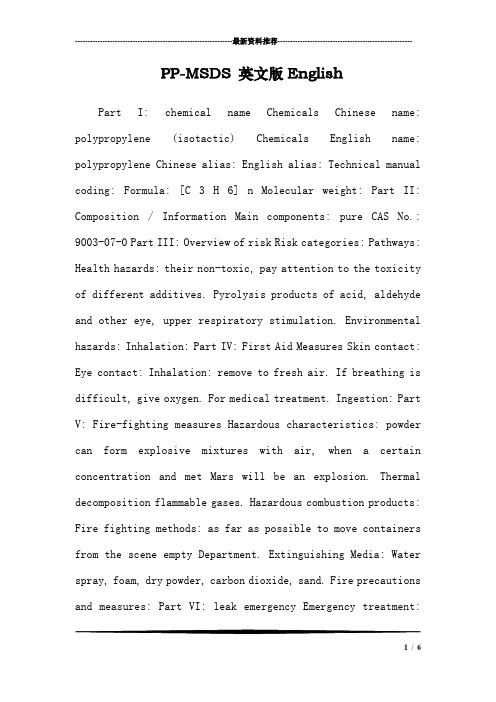
---------------------------------------------------------------最新资料推荐------------------------------------------------------PP-MSDS 英文版EnglishPart I: chemical name Chemicals Chinese name: polypropylene (isotactic) Chemicals English name: polypropylene Chinese alias: English alias: Technical manual coding: Formula: [C 3 H 6] n Molecular weight: Part II: Composition / Information Main components: pure CAS No.: 9003-07-0 Part III: Overview of risk Risk categories: Pathways: Health hazards: their non-toxic, pay attention to the toxicity of different additives. Pyrolysis products of acid, aldehyde and other eye, upper respiratory stimulation. Environmental hazards: Inhalation: Part IV: First Aid Measures Skin contact: Eye contact: Inhalation: remove to fresh air. If breathing is difficult, give oxygen. For medical treatment. Ingestion: Part V: Fire-fighting measures Hazardous characteristics: powder can form explosive mixtures with air, when a certain concentration and met Mars will be an explosion. Thermal decomposition flammable gases. Hazardous combustion products: Fire fighting methods: as far as possible to move containers from the scene empty Department. Extinguishing Media: Water spray, foam, dry powder, carbon dioxide, sand. Fire precautions and measures: Part VI: leak emergency Emergency treatment:1/ 6Isolation leak contaminated areas, restricting access. Cut off the fire source. Recommended emergency personnel wearing dust masks (full cover), wearing protective clothing. With clean shovel collection in a dry, clean, covered containers, transferred to a safe place. If large spills, recycling or collection shipped to the waste disposal sites.---------------------------------------------------------------最新资料推荐------------------------------------------------------ Part VII: Handling and Storage Handling Precautions: Storage: Store in a cool, ventilated warehouse. Away from fire and heat. Oxidants should be kept separate, sealed. Corresponding with the variety and quantity of fire-fighting equipment. Storage areas should be equipped with suitable host material spill. Part VIII: Exposure Control / Personal Protection Maximum allowable concentration: China MAC: 10; the former Soviet Union MAC: 10 Monitoring methods: Engineering controls: closed operation. Provide good natural ventilation. Respiratory protection: air concentrations exceeding the dust, it is recommended to wear self-absorption filter respirators. Eye protection: when necessary, wearing chemical protective safety glasses. Physical protection: wear protective clothing general operations. Hand protection: Wear protective gloves general operations. Other: no smoking scene work. Maintain good health habits. Part IX: Physical and Chemical Properties Appearance: white, odorless, tasteless solid. PH: Melting point (℃): 165-170 Boiling point (℃): Not available Relative density (water = 1): 0.90-0.91 Relative vapor density (air = 1): Not available Saturated vapor pressure (kPa): Not available Heat of combustion (kJ / mol): Not available Critical temperature3/ 6(℃): Not available Critical pressure (MPa): Not available Octanol / water partition coefficient as: Not available Flash point (℃): Not available Ignition temperature (℃): 420 (powder cloud) Explosion limit% (V / V): Not available Explosive limit% (V / V): 20 (g/m3) Solubility: Main purpose: used as engineering plastics for the system TV, radio shell, electrical insulation, corrosion pipes, plates, tanks, etc., but also for woven bags, packaging films. Other physical and chemical properties: Part 10: Stability and reactivity Stability: Conditions to avoid: INCOMPATIBILITY: Strong oxidizers. Hazardous Polymerization:---------------------------------------------------------------最新资料推荐------------------------------------------------------ Decomposition products: Part XI: Toxicological Information Acute toxicity: LD50: Not available, LC50: no information Subacute and chronic toxicity: Irritation: Sensitization: Mutagenicity: Teratogenicity: Carcinogenicity: Other: Part Ⅻ: Ecological Information Ecotoxicological toxicity: Biodegradation: Non-biodegradable: Bioconcentration or bioaccumulation of: Other harmful effects: Part ⅩⅢ: Waste disposal Nature of waste: Methods of disposal: Disposal in state and local regulations. Proposed incineration disposal. Waste Notes: Part XIV: Transport Information Dangerous Goods Code: no information UN Number: Not available Packaging signs: Packing Group: Z01 Packaging: No information. Transportation Note: Part XV: Regulatory Information National chemical safety regulations: Chemical Dangerous Goods Safety Management Regulations (February 17, 1987 the State Council), hazardous materials safety regulations implementation details (of labor [1992] No. 677), the workplace safe use of chemicals ([1996] Ministry of Labor No. 423) and other regulations for the safe use of hazardous chemicals, production, storage, transport, handling, etc. are made corresponding provisions; middle polypropylene plant air health standards (GB 16209-1996),5/ 6workshop provided the substance in the air and the maximum allowable concentration detection methods.。
PP聚丙烯安全资质资料表_MSDS

危险货物编号:无资料UN编号:无资料包装标志:无资料包装类别:Z01包装方法:无资料。
运输注意事项:起运时包装要完整,装载应稳妥。运输过程中要确保容器不泄漏、不倒塌、不坠落、不损坏。严禁与氧化剂等混装混运。运输途中应防曝晒、雨淋,防高温。
第十五部分:法规信息
法规信息:化学危险物品安全管理条例(1987年2月17日国务院发布),化学危险物品安全管理条例实施细则(化劳发[1992] 677号),工作场所安全使用化学品规定([1996]劳部发423号)等法规,针对化学危险品的安全使用、生产、储存、运输、装卸等方面均作了相应规定;车间空气中间聚丙烯卫生标准(GB 16209-1996),规定了车间空气中该物质的最高容许浓度及检测方法。
第七部分:操作处置与储存
操作注意事项:密闭操作。密闭操作,提供良好的自然通风条件。操作人员必须经过专门培训,严格遵守操作规程。建议操作人员佩戴自吸过滤式防尘口罩。远离火种、热源,工作场所严禁吸烟。使用防爆型的通风系统和设备。避免与氧化剂接触。搬运时要轻装轻卸,防止包装及容器损坏。配备相应品种和数量的消防器材及泄漏应急处理设备。倒空的容器可能残留有害物。
相对密度(水=1):0.90-0.91相对蒸气密度(空气=1):无资料饱和蒸气压(kPa):无资料
燃烧热(kJ/mol):无资料临界温度(℃):无资料临界压力(MPa):无资料辛醇/水分配系数的对数值:无资料
闪点(℃):无资料引燃温度(℃):420(粉云)爆炸上限%(V/V):20(g/m3)爆炸下限%(V/V):无资料
亚急性和慢性毒性:无资料刺激性:无资部分:生态学资料
生态毒理毒性:无资料生物降解性:无资料非生物降解性:无资料
生物富集或生物积累性:无资料其它有害作用:无资料。
MSDS-PP水
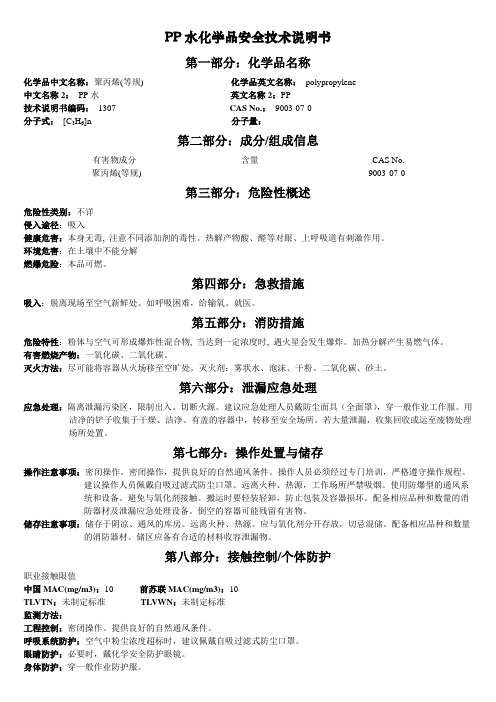
PP水化学品安全技术说明书第一部分:化学品名称化学品中文名称:聚丙烯(等规) 化学品英文名称:polypropylene中文名称2:PP水英文名称2:PP技术说明书编码:1307 CAS No.:9003-07-0分子式:[C3H6]n 分子量:第二部分:成分/组成信息有害物成分含量CAS No.聚丙烯(等规) 9003-07-0第三部分:危险性概述危险性类别:不详侵入途径:吸入健康危害:本身无毒, 注意不同添加剂的毒性。
热解产物酸、醛等对眼、上呼吸道有刺激作用。
环境危害:在土壤中不能分解燃爆危险:本品可燃。
第四部分:急救措施吸入:脱离现场至空气新鲜处。
如呼吸困难,给输氧。
就医。
第五部分:消防措施危险特性:粉体与空气可形成爆炸性混合物, 当达到一定浓度时, 遇火星会发生爆炸。
加热分解产生易燃气体。
有害燃烧产物:一氧化碳、二氧化碳。
灭火方法:尽可能将容器从火场移至空旷处。
灭火剂:雾状水、泡沫、干粉、二氧化碳、砂土。
第六部分:泄漏应急处理应急处理:隔离泄漏污染区,限制出入。
切断火源。
建议应急处理人员戴防尘面具(全面罩),穿一般作业工作服。
用洁净的铲子收集于干燥、洁净、有盖的容器中,转移至安全场所。
若大量泄漏,收集回收或运至废物处理场所处置。
第七部分:操作处置与储存操作注意事项:密闭操作。
密闭操作,提供良好的自然通风条件。
操作人员必须经过专门培训,严格遵守操作规程。
建议操作人员佩戴自吸过滤式防尘口罩。
远离火种、热源,工作场所严禁吸烟。
使用防爆型的通风系统和设备。
避免与氧化剂接触。
搬运时要轻装轻卸,防止包装及容器损坏。
配备相应品种和数量的消防器材及泄漏应急处理设备。
倒空的容器可能残留有害物。
储存注意事项:储存于阴凉、通风的库房。
远离火种、热源。
应与氧化剂分开存放,切忌混储。
配备相应品种和数量的消防器材。
储区应备有合适的材料收容泄漏物。
第八部分:接触控制/个体防护职业接触限值中国MAC(mg/m3):10 前苏联MAC(mg/m3):10TLVTN:未制定标准TLVWN:未制定标准监测方法:工程控制:密闭操作。
MSDS-PP聚丙烯
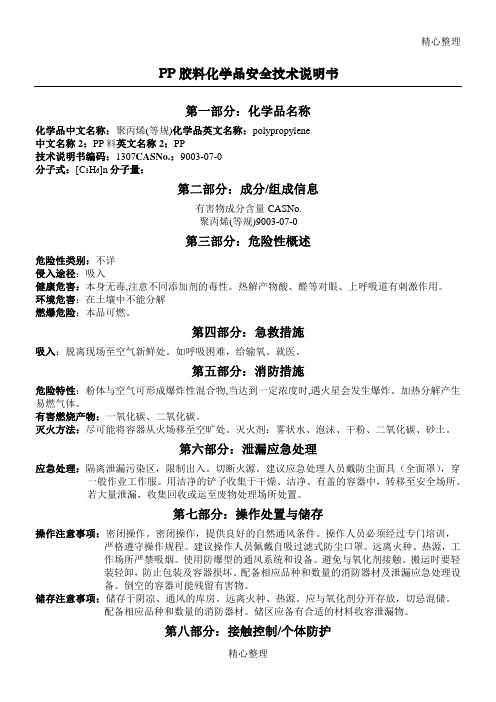
精心整理PP胶料化学品安全技术说明书第一部分:化学品名称化学品中文名称:聚丙烯(等规)化学品英文名称:polypropylene中文名称2:PP料英文名称2:PP技术说明书编码:1307CASNo.:9003-07-0分子式:[C3H6]n分子量:第二部分:成分/组成信息吸入,穿第七部分:操作处置与储存操作注意事项:密闭操作。
密闭操作,提供良好的自然通风条件。
操作人员必须经过专门培训,严格遵守操作规程。
建议操作人员佩戴自吸过滤式防尘口罩。
远离火种、热源,工作场所严禁吸烟。
使用防爆型的通风系统和设备。
避免与氧化剂接触。
搬运时要轻装轻卸,防止包装及容器损坏。
配备相应品种和数量的消防器材及泄漏应急处理设备。
倒空的容器可能残留有害物。
储存注意事项:储存于阴凉、通风的库房。
远离火种、热源。
应与氧化剂分开存放,切忌混储。
配备相应品种和数量的消防器材。
储区应备有合适的材料收容泄漏物。
第八部分:接触控制/个体防护职业接触限值中国MAC(mg/m3):10前苏联MAC(mg/m3):10TLVTN:未制定标准TLVWN:未制定标准监测方法:工程控制:密闭操作。
提供良好的自然通风条件。
呼吸系统防护:空气中粉尘浓度超标时,建议佩戴自吸过滤式防尘口罩。
眼睛防护:必要时,戴化学安全防护眼镜。
身体防护:穿一般作业防护服。
手防护:戴一般作业防护手套。
其他防护:工作现场严禁吸烟。
保持良好的卫生习惯。
第九部分:理化特性无资料燃烧热无资料闪点(℃)无资料生态毒理毒性:无资料生物降解性:无资料非生物降解性:无资料生物富集或生物积累性:无资料其它有害作用:无资料。
第十三部分:废弃处置废弃物性质:不详废弃处置方法:处置前应参阅国家和地方有关法规。
建议用焚烧法处置。
第十四部分:运输信息危险货物编号:无资料UN编号:无资料包装标志:无资料包装类别:Z01包装方法:无资料。
运输注意事项:起运时包装要完整,装载应稳妥。
运输过程中要确保容器不泄漏、不倒塌、不坠落、不损坏。
PP-MSDS 英文版English

---------------------------------------------------------------最新资料推荐------------------------------------------------------PP-MSDS 英文版EnglishPart I: chemical name Chemicals Chinese name: polypropylene (isotactic) Chemicals English name: polypropylene Chinese alias: English alias: Technical manual coding: Formula: [C 3 H 6] n Molecular weight: Part II: Composition / Information Main components: pure CAS No.: 9003-07-0 Part III: Overview of risk Risk categories: Pathways: Health hazards: their non-toxic, pay attention to the toxicity of different additives. Pyrolysis products of acid, aldehyde and other eye, upper respiratory stimulation. Environmental hazards: Inhalation: Part IV: First Aid Measures Skin contact: Eye contact: Inhalation: remove to fresh air. If breathing is difficult, give oxygen. For medical treatment. Ingestion: Part V: Fire-fighting measures Hazardous characteristics: powder can form explosive mixtures with air, when a certain concentration and met Mars will be an explosion. Thermal decomposition flammable gases. Hazardous combustion products: Fire fighting methods: as far as possible to move containers from the scene empty Department. Extinguishing Media: Water spray, foam, dry powder, carbon dioxide, sand. Fire precautions and measures: Part VI: leak emergency Emergency treatment:1/ 6Isolation leak contaminated areas, restricting access. Cut off the fire source. Recommended emergency personnel wearing dust masks (full cover), wearing protective clothing. With clean shovel collection in a dry, clean, covered containers, transferred to a safe place. If large spills, recycling or collection shipped to the waste disposal sites.---------------------------------------------------------------最新资料推荐------------------------------------------------------ Part VII: Handling and Storage Handling Precautions: Storage: Store in a cool, ventilated warehouse. Away from fire and heat. Oxidants should be kept separate, sealed. Corresponding with the variety and quantity of fire-fighting equipment. Storage areas should be equipped with suitable host material spill. Part VIII: Exposure Control / Personal Protection Maximum allowable concentration: China MAC: 10; the former Soviet Union MAC: 10 Monitoring methods: Engineering controls: closed operation. Provide good natural ventilation. Respiratory protection: air concentrations exceeding the dust, it is recommended to wear self-absorption filter respirators. Eye protection: when necessary, wearing chemical protective safety glasses. Physical protection: wear protective clothing general operations. Hand protection: Wear protective gloves general operations. Other: no smoking scene work. Maintain good health habits. Part IX: Physical and Chemical Properties Appearance: white, odorless, tasteless solid. PH: Melting point (℃): 165-170 Boiling point (℃): Not available Relative density (water = 1): 0.90-0.91 Relative vapor density (air = 1): Not available Saturated vapor pressure (kPa): Not available Heat of combustion (kJ / mol): Not available Critical temperature3/ 6(℃): Not available Critical pressure (MPa): Not available Octanol / water partition coefficient as: Not available Flash point (℃): Not available Ignition temperature (℃): 420 (powder cloud) Explosion limit% (V / V): Not available Explosive limit% (V / V): 20 (g/m3) Solubility: Main purpose: used as engineering plastics for the system TV, radio shell, electrical insulation, corrosion pipes, plates, tanks, etc., but also for woven bags, packaging films. Other physical and chemical properties: Part 10: Stability and reactivity Stability: Conditions to avoid: INCOMPATIBILITY: Strong oxidizers. Hazardous Polymerization:---------------------------------------------------------------最新资料推荐------------------------------------------------------ Decomposition products: Part XI: Toxicological Information Acute toxicity: LD50: Not available, LC50: no information Subacute and chronic toxicity: Irritation: Sensitization: Mutagenicity: Teratogenicity: Carcinogenicity: Other: Part Ⅻ: Ecological Information Ecotoxicological toxicity: Biodegradation: Non-biodegradable: Bioconcentration or bioaccumulation of: Other harmful effects: Part ⅩⅢ: Waste disposal Nature of waste: Methods of disposal: Disposal in state and local regulations. Proposed incineration disposal. Waste Notes: Part XIV: Transport Information Dangerous Goods Code: no information UN Number: Not available Packaging signs: Packing Group: Z01 Packaging: No information. Transportation Note: Part XV: Regulatory Information National chemical safety regulations: Chemical Dangerous Goods Safety Management Regulations (February 17, 1987 the State Council), hazardous materials safety regulations implementation details (of labor [1992] No. 677), the workplace safe use of chemicals ([1996] Ministry of Labor No. 423) and other regulations for the safe use of hazardous chemicals, production, storage, transport, handling, etc. are made corresponding provisions; middle polypropylene plant air health standards (GB 16209-1996),5/ 6workshop provided the substance in the air and the maximum allowable concentration detection methods.。
聚酰胺型自融性凡立水物质安全数据表MSDS

一、物品与厂商资料 物品名称 : 聚酰胺型自融性凡立水 物品编号 : 制造商或供货商名称 : XX化学股份有限公司 地址 :XX村55-1号 紧急联络电话/传真电话 :
ห้องสมุดไป่ตู้
二、成分辨识资料 纯物质: 中英文名称 : 聚酰胺型自融性凡立水(Polyamide 同义名称 : FSB PS 16 化学文摘社登记号码(CAS No.) : 危害物质成分(成分百分比) :
Self-Bonding Insulating Varnish)
混合物:
化学性质:稳定的漆包线绝缘凡立水
危害性成分
化学文摘社 浓度或浓度范围
危害物质
中英文名称
化学式 登记号码Cas No. (成分百分比)
分类及图式
甲酚 CRESOL
C7H8O
00108-39-4
33.6%
1.健康危害等级3 2.火灾危害等级1
酚 PHENOL
C6H6O
00108-95-2
33.6%
3.反应性等级0 4.危险物分类3.Ⅲ及6.1.Ⅰ, 8类
二甲苯 XYLENE
C8H10
00106-42-3
16.8%
聚酰胺树脂
Polyamide Resin
16.0%
三、危害辨识数据 健康危害效应:进入人体之途径 [V]吸入 [V]皮肤接触 [x]吞食 环境影响:环境温度高时易受气象伤害。
(4) 250ppm :正压式或供压式之全面型供压式呼吸防护具。 卫生措施: 1. 工作后尽速脱掉污染之衣物,洗净后才可再穿戴或丢弃,且须告知洗衣人员污染物之危害性。 2.工作场所严禁抽烟或饮食。
第2頁
3.处理此物后,须彻底洗手。 4.维持作业场所清洁。
危化品MSDS-30%过氧化氢

过氧化氢,30%水溶液1. 化学品及企业标识化学品中文名称:过氧化氢,30%水溶液化学品英文名称:hydrogen peroxide中文名称2:双氧水主要用途:用于漂白,用于医药,也用作分析试剂。
2. 危险性概述2.1 危险性类别:氧化剂、腐蚀品。
2.2侵入途径:吸入、食入。
2.3健康危害:吸入本品蒸气或雾对呼吸道有强烈刺激性,一次大量吸入可引起肺炎或肺水肿。
眼直接接触液体可致不可逆损伤甚至失明。
口服中毒出现腹痛、胸口痛、呼吸困难、呕吐、一时性运动和感觉障碍、体温升高等。
个别病例出现视力障碍、癫痫样痉挛、轻瘫。
长期接触本品可致接触性皮炎。
2.4 环境危害:无资料。
2.5燃爆危险:助燃。
与可燃物混合会发生爆炸。
在限制性空间中加热有爆炸危险。
3. 成分/组成信息纯品■混合物□主要成分CAS RN 含量(%)过氧化氢7722-84-1 ≥30.04. 急救措施4.1 皮肤接触:立即脱去污染的衣着,用大量流动清水冲洗20~30 分钟。
如有不适感,就医。
4.2眼睛接触:立即提起眼睑,用大量流动清水或生理盐水彻底冲洗10~15 分钟。
如有不适感,就医。
4.3吸入:迅速脱离现场至空气新鲜处。
保持呼吸道通畅。
如呼吸困难,给输氧。
呼吸、心跳停止,立即进行心肺复苏术。
就医。
4.4食入:饮水,禁止催吐。
如有不适感,就医。
5. 消防措施5.1 危险特性:爆炸性强氧化剂。
过氧化氢本身不燃,但能与可燃物反应放出大量热量和氧气而引起着火爆炸。
过氧化氢在pH值为3.5~4.5 时最稳定,在碱性溶液中极易分解,在遇强光,特别是短波射线照射时也能发生分解。
当加热到100℃以上时,开始急剧分解。
它与许多有机物如糖、淀粉、醇类、石油产品等形成爆炸性混合物,在撞击、受热或电火花作用下能发生爆炸。
过氧化氢与许多无机化合物或杂质接触后会迅速分解而导致爆炸,放出大量的热量、氧和水蒸气。
大多数重金属(如铁、铜、银、铅、汞、锌、钴、镍、铬、锰等)及其氧化物和盐类都是活性催化剂,尘土、香烟灰、碳粉、铁锈等也能加速分解。
MSDS-PP聚丙烯

精心整理PP胶料化学品安全技术说明书第一部分:化学品名称化学品中文名称:聚丙烯(等规)化学品英文名称:polypropylene中文名称2:PP料英文名称2:PP技术说明书编码:1307CASNo.:9003-07-0分子式:[C3H6]n分子量:第二部分:成分/组成信息吸入,穿第七部分:操作处置与储存操作注意事项:密闭操作。
密闭操作,提供良好的自然通风条件。
操作人员必须经过专门培训,严格遵守操作规程。
建议操作人员佩戴自吸过滤式防尘口罩。
远离火种、热源,工作场所严禁吸烟。
使用防爆型的通风系统和设备。
避免与氧化剂接触。
搬运时要轻装轻卸,防止包装及容器损坏。
配备相应品种和数量的消防器材及泄漏应急处理设备。
倒空的容器可能残留有害物。
储存注意事项:储存于阴凉、通风的库房。
远离火种、热源。
应与氧化剂分开存放,切忌混储。
配备相应品种和数量的消防器材。
储区应备有合适的材料收容泄漏物。
第八部分:接触控制/个体防护职业接触限值中国MAC(mg/m3):10前苏联MAC(mg/m3):10TLVTN:未制定标准TLVWN:未制定标准监测方法:工程控制:密闭操作。
提供良好的自然通风条件。
呼吸系统防护:空气中粉尘浓度超标时,建议佩戴自吸过滤式防尘口罩。
眼睛防护:必要时,戴化学安全防护眼镜。
身体防护:穿一般作业防护服。
手防护:戴一般作业防护手套。
其他防护:工作现场严禁吸烟。
保持良好的卫生习惯。
第九部分:理化特性无资料燃烧热无资料闪点(℃)无资料生态毒理毒性:无资料生物降解性:无资料非生物降解性:无资料生物富集或生物积累性:无资料其它有害作用:无资料。
第十三部分:废弃处置废弃物性质:不详废弃处置方法:处置前应参阅国家和地方有关法规。
建议用焚烧法处置。
第十四部分:运输信息危险货物编号:无资料UN编号:无资料包装标志:无资料包装类别:Z01包装方法:无资料。
运输注意事项:起运时包装要完整,装载应稳妥。
运输过程中要确保容器不泄漏、不倒塌、不坠落、不损坏。
